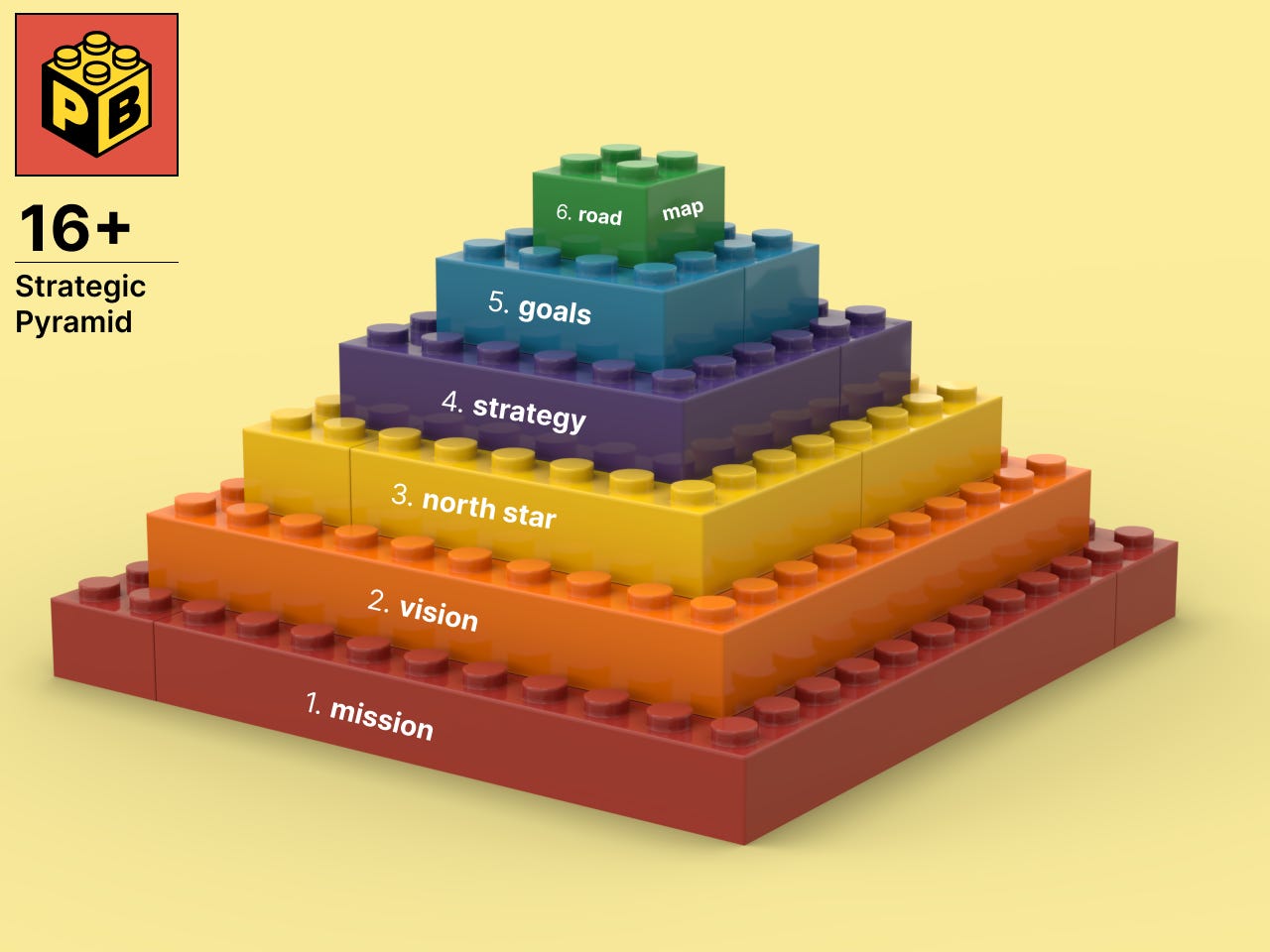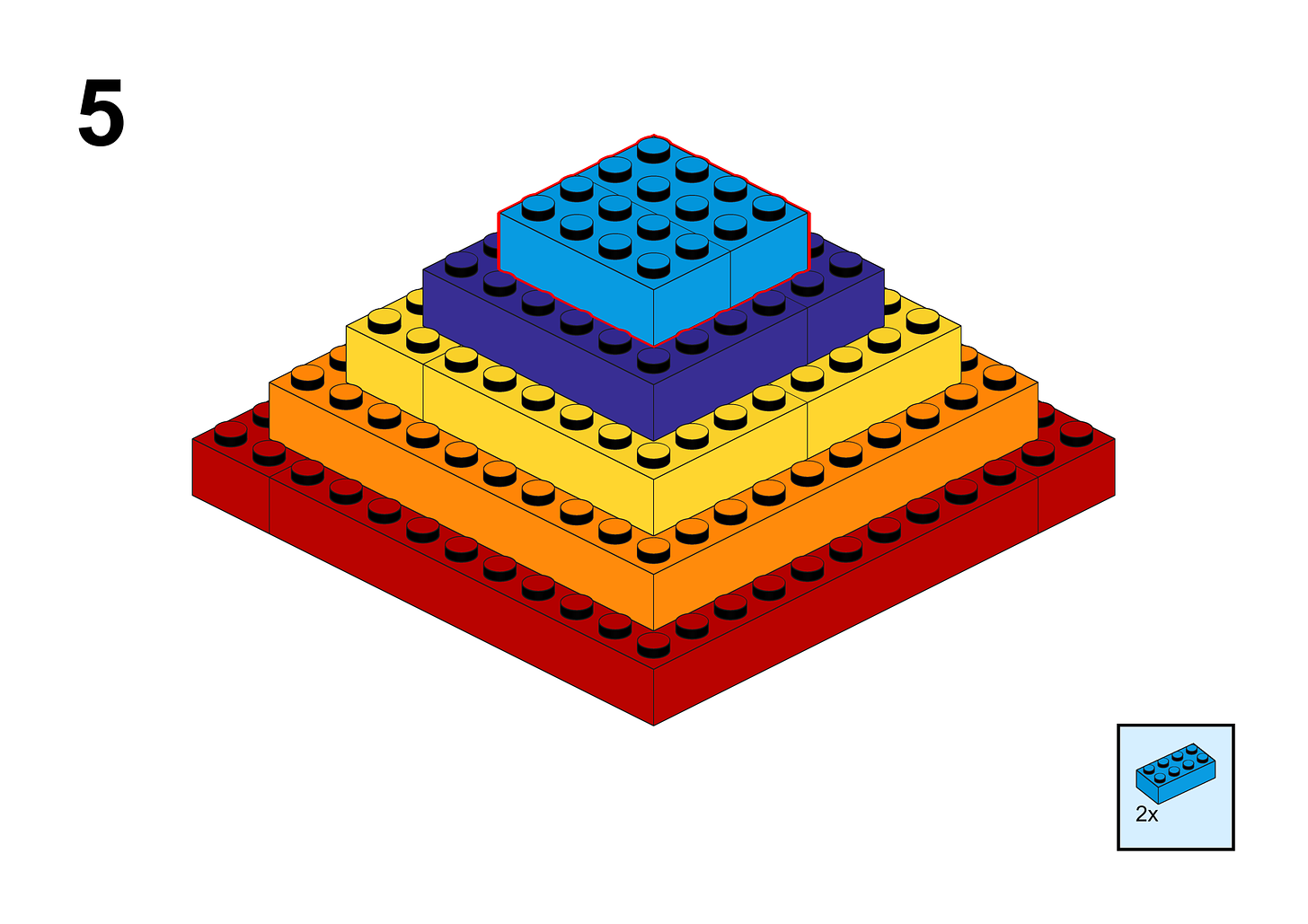Netflix's Strategic Pyramid case study ↔️ Mission → Vision → North Star → Strategy → Goals → Roadmap
Get better at prioritizing and improve your business results. Reduce your fear of strategy. Get inspired to build your own Strategic Pyramid with Netflix's Case Study.
👋 Hey! My name is Piotr, and welcome to my newsletter on the building blocks of successful tech product companies.
Over my 20 years in tech, I worked with a handful of product companies in various roles - from individual contributor to leader and coach.
Common complaints are:
Teams have issues prioritizing items on the roadmap
Teams are not bringing any significant business results
There is no clear focus, and teams are all around the place
There is a misalignment between different departments
There are many communication and coordination issues between the teams
Rings a bell?
Those issues tell that you may be lacking a strategy.
In this post, you’ll learn how to fix those issues by creating a strategy step-by-step using Netflix as an example.
What is the Strategic Pyramid?
Strategic Pyramid documents your entire strategy.
It paints the picture of the future your company is trying to unlock.
It describes the direction company wants to take to get there.
It illustrates the journey from a high-level mission to a day-to-day roadmap.
Its goal is to give teams inspiration, direction, and focus.
Strategic pyramid layers
Every layer is an answer to one question:
Mission 👉 Why do we exist as a company?
Vision 👉 What’s the future we want to unlock in 2-3 years?
North Star Metric 👉 What is the single, most crucial metric that best captures the core value that our product delivers to its customers?
Strategy 👉 What is the sequence of big bets that will take us to that future?
Metrics & Goals 👉 How will we measure progress on those bets?
Roadmap 👉 What tactics are we planning to launch to move those goals?
Why Pyramid?
Pyramid is a good metaphor because:
The strategy has multiple connected layers.
Layers provide the base for the other layers.
Lower layers guides the upper layers.
The sequence of layers matters.
Why do you need Strategic Pyramid?
To achieve better business results
To allow teams to prioritize their work better
To scale your company
To provide your teams’ information necessary to make decisions
To provide focus
To align teams
To measure progress
To inspire and motivate
Netflix’s Strategic Pyramid Example
I’ll show you what Netflix’s strategy could look like using Strategic Pyramid.
I used some insights from Gibson Biddle (Netflix ex VP of Product). As for the rest - I’m speculating here.
Mission:
Question: Why do we exist as a company?
Answer: to entertain the world anywhere, anytime.
Vision:
Q: What’s the future we want to unlock in 2-3 years?
A: to become the go-to entertainment platform providing memorable experiences to people globally
North Star Metric:
Q: What is the single, most crucial metric that best captures the core value our product delivers to its customers?
A: the number of hours customers spend streaming content on its platform.
Strategy:
Q: What is the sequence of big bets that will take us to that future?
A: Here are the major strategic bets:
Getting into gaming
Adding short video content
Embracing interactive storytelling
Investing in original content (continue)
Expanding globally (continue)
Personalizing the viewing experience (continue)
Metrics & Goals:
Q: How will we measure progress on those bets?
A:
Original Content → % of members who watch at least 10 hours/month of Original Content
Watching experience → % of customers who watch at least 30 hours/month
Getting into gaming → % of members who played Netflix Games
Adding short video content → % of members who engage with short video content
Roadmap:
Q: What tactics are we planning to move those goals?
A: Here’s the rolling four-quarter roadmap per each strategy:
I hope you see why there is a specific sequence and how each layer feeds the next one.
Read below if you’re interested in how I came to those answers.
Strategic Pyramid layers step-by-step
1. Mission
Mission answers a question:
Why do we exist as a company?
A company mission is a single sentence that defines its reason for existence.
Netflix’s mission could be: ”to entertain the world anywhere, anytime.”
Netflix’s mission statement emphasizes the company’s purpose of using innovative and engaging storytelling to entertain and connect people worldwide. This focus on accessibility reflects Netflix’s strategy of disrupting traditional media distribution channels and becoming a global entertainment platform.
Hint: If you’re stuck, use ChatGPT to help you create your mission (example: write an inspiring single-sentence company mission statement about this company: «company context»)
2. Vision:
Vision answers a question:
What’s the future we want to unlock in 2-4 years?
Netflix has existed for more than 20 years. Their vision has changed over time, but I imagine their previous vision statements gravitated around:
DVD by mail → Streaming → Expansion worldwide → Original Content
Based on Netflix’s experiments with gaming and short video content, my guess for current Netflix’s vision for the next 2-4 years could be: “to become the go-to entertainment platform providing memorable experiences to people globally.”
At this point is quite clear Netflix’s ambitions are higher than just streaming.
Although gaming may seem insignificant now, it’s worth remembering that in January 2007, Netflix started with just a few hundred streaming titles to support its DVD rental service. And now, the company has become one of the biggest players in the market.
Big bets require faith and a considerable amount of time.
Hint: If you’re stuck, use ChatGPT to help create your vision statement.
3. North Star
The North Star answers the question:
What is the single, most crucial leading metric best captures the core value our product delivers to its customers?
It’s like a compass that helps guide the business in the right direction to achieve its ultimate goal.
Netflix North Star metric fifteen years ago was the number of DVDs in a new member’s queue. This was a leading indicator that helped improve their retention.
Since Netflix shifted from DVD by mail to streaming, its current North Star metric could be the number of hours customers spend watching or engaging with the content on its platform.
This metric directly reflects the value that Netflix provides to its customers, which is high-quality and engaging content. By focusing on increasing the number of hours customers spend streaming, Netflix can ensure that it delivers sufficient value to its customers and achieves long-term growth. If they hit their North Star metric, other metrics, such as customer retention, subscriber growth, and revenue per user, will follow.
4. Strategy
Strategy answers the question:
What is the sequence of big bets that will take us to that future?
A good strategy should tick all the boxes:
provide value for the customer
increase company profits
is hard to copy by competitors
Current Netflix strategies include:
Getting into gaming: Developing or acquiring games that tie in with Netflix original content or partnering with game developers to bring Netflix content into the gaming world.
Adding short video content: Creating or acquiring short-form video content, such as snackable clips, to keep subscribers engaged and attract new ones.
Embracing interactive storytelling: Developing or acquiring content that allows viewers to make choices and affect the story’s outcome, creating a more immersive and engaging experience.
Investing in original content: Continuing to produce and acquire exclusive, high-quality original content to differentiate themselves from competitors and keep subscribers engaged.
Expanding globally: Continuing investing in local content and partnerships to better serve international markets and tapping into new, untapped subscriber bases.
Experimenting with new business models: Continuing testing new pricing structures, such as a lower-cost, ad-supported option or offering discounts for longer-term commitments.
Personalizing the viewing experience: Netflix continues using subscriber data to tailor recommendations and create a unique, personalized experience for each user.
As you can see, strategies are not features or other tactics. Each strategy should provide an answer to why areyou doing specific tactics.
Strategy also answers which bets you’re not willing to take.
Here are strategies that Netflix decided not to follow now:
Social aspects of watching: recommendations based on friends’ watchlists or shared watching. Netflix has experimented with that in the past but did not succeed. I guess no one wants the world to know what weird stuff you’re into. ;)
Investing in cutting-edge technologies, such as virtual and augmented reality, to offer a more immersive viewing experience.
5. Metrics and goals
Every strategy should include a metric to measure progress.
In Netflix’s case, these could be:
Original Content → % of members who watch at least 10 hours/month of Original Content
Watching experience → % of customers who watch at least 40 hours/month
Getting into gaming → % of members who played Netflix Games
Adding short video content → % of members who engage with short video content
Once you have a metric assigned to strategies, you can set goals (for example, using OKRs):
Strategy: Original Content
Metric: % of members who watch at least 10 hours/month of Original Content
Goal: increase it by 2% in the next 3/6/12 months
6. Tactics & roadmap
A roadmap answers the final question:
What tactics will we use to progress the goals we’ve set, within the strategies we picked, that should get us closer to our vision?
By tactics, I mean products, projects, features, and experiments.
Here’s what Netflix rolling four-quarter roadmap may look like:
A very common mistake is to create a roadmap before the strategy.
I strongly advise against it as it removes all the thinking needed beforehand, ultimately leading to lower business outcomes and teams jumping from one thing to another. Do your homework.
Conclusion
Providing strategy to teams is the most important job for a leader. It can seem scary, but if you use a simple model like Strategic Pillar, you’ll have it done within weeks. Do your job, leaders! If you need help, here’s how I can help.
Other reads
Have a wonderful week!
Piotr 👋













